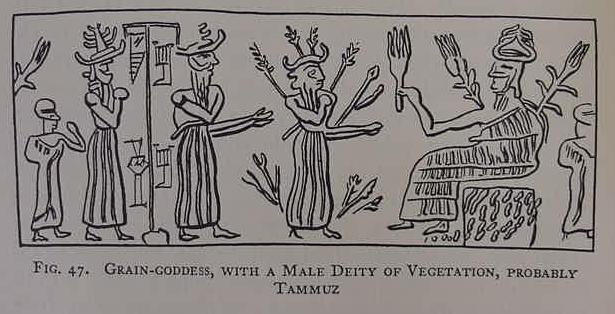Langdon noted that Tammuz/Dumuzi had many roles and manifestations. He was not only associated with dying and resurrceted vegetation, he was also identified with freshwater, for water was essential in the irrigation canals of lower Mesopotamia to sustain life. A number of hymns ask Damu/Dumuzi to "arise from the river," to a degree, the annual flooding or rising of the Euphrates and Tigris rivers would assure plentiful water for crops.
"O man, my Damu, my irrigator thou art." (p. 343, Langdon)
He was also identified with a brilliant star constellation he being a guard at the gate of Anu the supreme god of Heaven:
"O Dumuzi, shepherd of Anu, the brilliant, spouse of Ishtar...eater of roasted bread, baked cakes..." (p. 344. Langdon)
"From the river, from the river arise, rejoice...O Damu, from the river arise.." (p. 348. Langdon)
"Return O lord, provide the flood, the spade labors nought, but the granaries shall be heaped" (p. 351. Langdon)
Langdon also noted that Tammuz in some hymns is compared to the sun-god (Sumerian Utu, Akkadian Shamash). I suspect that as the sun each day goes through a cycle of setting and rising, that this may have been seen as a type of death and ressuerction and thus this phenomenon was tagged on to the death and resurrection of plantlife.
Of interest here is that Jesus the Christ declares he is the bread (grain?), the true vine, the source of the waters of life, motifs awhich appeared in earlier Mesopotamian motifs associated with resurrected gods like Damu/Dumuzi, Ningishzida and Geshtinanna. Sunrise services at Easter might recall Tammuz's identification with the rising and setting sun called Shamash.
"O my exalted one, in thy rising...who is like Shamash? Thou art like Shamash." (p. 343. Langdon).
Some Tammuz hymns have two or three women mourning Tammuz, his mother, sister and sometimes his wife. Could these three have been transformed into the mourning women who came to Christ's tomb to discover he had risen from the dead?
